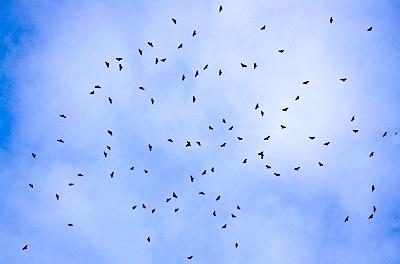While most people think of the four seasons we all know so well, birders have a different calendar with more descriptive headings than “spring” and “winter.” And right now we are at the peak of hawk season.
In late summer and early autumn every year, raptors in extraordinary numbers migrate from their nesting grounds to more hospitable winter climes. Thousands of hawks can be spotted on good days at some of North America’s premier hawk-watching sites. The aptly-named Hawk Ridge in Pennsylvania’s Allegheny Mountains is a notable destination for birders. In Washington last weekend, they celebrated the Chelan Ridge Hawk Migration Festival near the Lake Chelan National Recreation Area in Washington state.
It’s hard to beat the scenery of the North Cascades, but my sentimental favorite spot for hawk-watching has to be Cadillac Mountain in Acadia National Park.
Geography and national park buffs will know Cadillac Mountain as the highest vantage point on the East Coast of the United States as well as the spot where one can be the first person in the country to see the sunrise from October into March. More than mere trivia, those are also precisely what make Cadillac Mountain a wonderful raptor migration spot.
Think Like A Hawk
To find migrating raptors, you need to think like a hawk.
It’s a long flight to your subtropical winter home, so you’d better be sure you keep up your energy. As a soaring bird, you know that with your wings spread out you can fly into upwellings of warm air and maintain (or even gain) altitude without bothering to flap at all.
Since you’re an exceptionally smart hawk, you realize that on sunny days you can find these “thermals” along ridge lines and peaks where the warm air runs into obstacles and is forced upward. You also know that along the shores of large lakes and oceans, the cool air off the water will slide under warmer air, again creating a thermal. So, as you head down the eastern coast, Acadia National Park with its north-south oriented ridges and the Atlantic Ocean mere meters away looks like a great spot to get a quick boost without expending any energy.
Now that we know what the hawks are thinking, we’re going to grab our binoculars and head out to one of the most scenic spots in the National Park System and see many raptors we can spot.
From late August to mid-October every year, park rangers, volunteers, and visiting birders scan the skies above, and sometimes below, Cadillac Mountain to count raptors. Sharp-shinned hawks and American Kestrels are two of the most common sightings, though just about any raptor can show up at any time. Yearly totals average more than 2,500 birds over the watch season. Some other sites can have more birds than that in a single afternoon, but again, sitting on Cadillac Mountain under an October sun counting hawks is hard to beat.
Watching Hawks
If you haven’t been to a hawk watch, you should give it a try. One thing to be aware of is that there’s a steep learning curve to identifying raptors, particularly hawks, in flight at a distance. Some of the skilled hawk-watchers can tell a red-tailed hawk from a red-shouldered as mere specks a mile away.
No, they aren’t able to see the color of the tail or shoulders! Their trick is years of practice discerning subtle differences in shape and flight patterns. But while it might be challenging, what better way to learn than to visit a hawk watch where there will inevitably be a few experts around to point out what field marks they’re using to identify the birds?
Other than watching raptors with the raptor-watching veterans, there are a few great books on the market to aid the budding hawk-watcher. The second edition of the classic Hawks in Flight by Pete Dunne, David Sibley, and Clay Sutton is due out next week.
Dunne is considered one of the world’s most astute birders and Sibley among its best bird artists. Their combined efforts are bound to be as exceptional as the legendary original edition from 1989. Utah birder Jerry Liguori has a couple books that can be quite helpful as well. Hawks at a Distance is essentially a book full of pictures of black specs in the sky, but it’s immensely helpful, since that is often exactly what you see when looking for hawks. Liguori also gives us Hawks From Every Angle, which highlights some identification tricks for the occasions when the birds accommodate you with a closer view.
With those books in your pack, some good binoculars around your neck, and a ticket to your nearest hawk watch, you’ll be set to count raptors with the pros.
You can keep up with hawk counts at over 200 locations at www.hawkcount.org.




Comments
Great article and thanks for the heads up on Cadillac Mountain. We just moved to ME and live less than ten miles from Acadia. Have been to Hawk Ridge and it was an amazing experience!